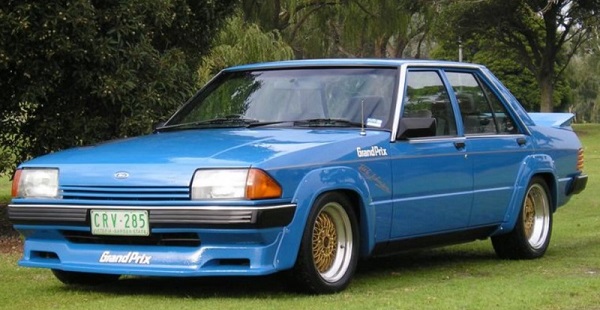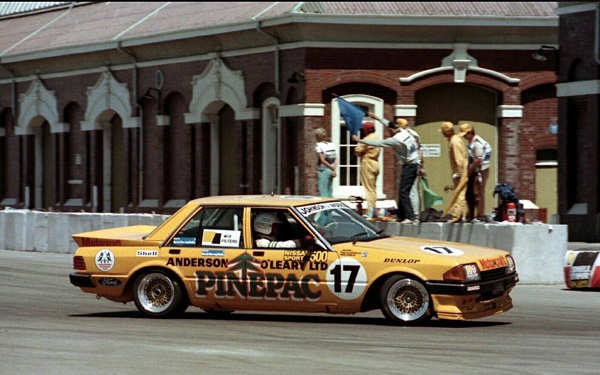Long time readers of this blog will know that I am a motor racing fan and that being an Australian motor racing fan, that invariably means the Australian Touring Car Championship.
While the number of rule changes over the years has been many, they broadly fall into a period before the adoption of Group C, a period where cars were running to international Group A regulations, and lastly the creation of the V8Supercars regulations which are actually just a series of increasingly divergent rules which were based upon Group 3A within Group A.
That period of international Group A racing is more interesting as the current V8Supercars because the kinds of machinery which was being entered, was as diverse as the countries which all ran it. That large kind of diversity is kind of what I think has informed the framing of the current FIA GT3 regulations and the buckwild flood of fabulousness that is Japan's Super GT300 category. Equally as interesting though, is speculating what could have been and what never was.
Group A started in Europe in 1982 and Australia adopted it in 1985. For any car to be eligible it had to be produced in a minimum quantity of 5000 units per year (though what defined a "year" remained unclear. Engine modifications were limited and sensible. Gearboxes and brakes were free provided they were homologated by the manufacturer. And suspensions could be modified provided they maintained the road car’s original design and mounting points.
There were three classes based on engine capacity (less than 1600cc, 1600-2500cc, and over 2500cc) and the thread that tied these classes together was a sliding scale of performance that matched different engine capacities with minimum weights, maximum tyre widths and fuel tank capacities. Naturally, the weight/tyre/fuel dimensions increased with engine sizes. The FIA descided to run a very blunt equivalency factor for turbocharged engines (cubic engine capacity x 1.4) to keep them in line with non-turbo engines; which was also woefully inadequate given the huge power increases that occurred.
Then the requirement for a minimum 500 ‘evolution’ versions of the base model car saw street-legal race weapons created like the turbocharged Volvo 240T, Ford Sierra-Cosworth RS500 and BMW M3. By the time the definitive twin-turbo, all-wheel drive Nissan GT-R arrived in 1990, the category had already self-destructed in Europe and Australia and other countries inevitably followed. It is worth mentioning that although Holden played by the rules that they thought everyone else had agreed to, they also failed to build the required 500 cars for their VN Commodore SS Group A SV in 1991.
From what I understand, the following modifications were allowed according to FIA Group A regulations:
- Full suspension geometry and layout but the original mounting points must be preserved within a 20mm radius
- Engine internals including camshafts, crankshaft, valves. Other engine components can be machined. The engine bloc must be preserved
- Engine peripherals (Radiators, intercoolers, turbos?)
- Engine management
- Gearbox, gear ratios, number of gears and gear selection type
- Differentials
- Final drive ratio
- Electric equipment
This is where is gets incredibly curious.
Ford stopped making the Cleveland V8 in 1982. That meant that their supply of 4.9L and 5.8L V8s dried up mid way through the run of the XE Falcon. Dick Johnson built his own turbocharged version of the 4.1 litre six cylinder Falcon which put out 190kW; which made the 5.0L V8 VH Commodore look pedestrian at only 126kW.
Johnson took the four-speed manual gearbox, clutch and the limited-slip-differential from the Falcon V8 ESP (European Sport Pack). 50 examples were built; which given that they were modified from existing production cars, actully might have complied with Group A regulations.
What I can never know is if Dick Johnson was able to turn the 4.1L Thriftpower Six into a turbocharged engine, whether or not Ford Australia would have ever been persuaded to come to the party and build the necessary 500 of them to homologate the car. I also don't know if the Confederation of Australian Motorsports would have given the Turbo Falcon special dispensation to run in Australia if the 500 examples required under the rules were never built. My suspicion is that they would have done and that the entire trajectory of Australian motor racing would have been changed.
If Dick Johnson who was obviously a decent engineer and had some pretty good engine builders in the Stone brothers, who would themselves eventually go on to become race winning team owners, then it will come as no surprise that Ford Australia would eventually make the Thriftpower Six into a production turbocharged engine and put it in the Falcon XR6 Turbo (albeit the later 4.0L version)
Dick Johnson bought two Fox body Mustangs from Zakspeed in Germany and it must be said that in comparison to what they were up against in Germany they were fine but when they came to Australia and went up against the likes of the Holden Commodore VK, Nissan Skyline GTS Turbo, Volvo 240 Turbo, and even the underpowered BMW 635, they were hopeless. Dick Johnson would himself campaign Ford Sierras which ended up being the fastest in the world and being the only cars to pose any real threat to the Nissan Skyline GTR R32 when it arrived but there was a curious car that I only found out about recently which I think could have been a proper missile.
The strange new unknowable future may have very well seen Holden throw their Piazza Turbo and then the Calibra Turbo 4WD against the Nissans and that would have been brilliant. We might also have had road racing versions of the cars which were being entered in the World Rally Championship such as the Mitsubishi Lancer Evo, Subaru Impreza WRX etc. which was exactly the reason why the FIA had made the Group A regulations for both rallying and circuit racing initially identical. Both the Ford Sierra Cosworth and the BMW M3 saw use in both disciplines.
The story might have ended differently in another way as well. There was one XE Falcon with the 351 Cleveland V8 which had been modified to comply with the Group A regulations which was run by Bruce Anderson in New Zealand. It was definitely modified from a car of which there had been 5000 standard cars and 500 homologation examples built. In that respect, I can only think that the sliding scale of weights must've crippled the Falcons in Australia which is why nobody chose to run one here.
Since Ford Motor Company of New Zealand Limited was essentially a subsidiary of the Ford Motor Company of Canada, there is a posibility that had NZ not lowered its tariffs in the mid 1980s then an Australian produced XF Falcon might have landed in NZ without an engine and then been fitted with the 302 Windsor V8 like it eventually was with the 1991 EB Falcon. There is an outside possibility that there could have been a Group A 5L V8 Falcon, six years before it actually arrived but again, all of this is mass speculation.



No comments:
Post a Comment